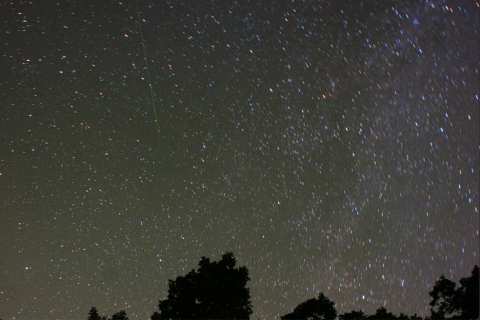Tips on How to View the Perseid Meteor Shower
By Madison Berry, UNH Marketing and Communications Intern
Mark your calendars for the night of August 11th and 12th, 2024, and prepare to be amazed – the Perseid meteor shower is known to put on a mesmerizing show!
In an interview with the UNH Observatory director John Gianforte, he explains what the Perseid meteor shower is and some of the best practices for watching it.
The Perseid meteor shower is one of the best “reliable annual” meteor showers, meaning, it happens every year around the same time. This year, the meteor shower will start during the second week of August and will peak around the nights of August 11th and 12th. Every year during this meteor shower you can count on between 50 to 100 Perseids meteors per hour during the peak.
Three Astronomy Words that are Often Confused
Gianforte explains the three most common meteor-related words that are often confused.
- Meteoroids: Dust particles that are orbiting the sun, each in their own orbit. They are “minding their own business” out in the solar system.
- Meteors: The streak of light in the sky that are often referred to as “shooting stars.” Most of them burn up about 40 to 60 miles above the Earth, but some of them make it to Earth.
- Meteorites: When meteors make it to Earth’s surface.

When watching a meteor shower, remember to have patience and allow your eyes to adjust to the night sky.
How to Know if the Meteor is a Perseid
Gianforte explains that when watching the meteor shower, most of the meteors are a part of the Perseid shower but some can be sporadic and not a part of the Perseid event. He says, “In the case of the Perseid meteor shower, you can always tell it is a Perseid if the meteors appear to come from the constellation Perseus. You can trace the meteor’s path back and if it is a meteor from the Perseid shower then it will always lead back to a region between the constellation Cassiopeia and Perseus.”
Tips for Watching the Meteor Shower
Gianforte says, “The only skill you need to do this is patience, patience to wait for them and allow your eyes to adjust to the night sky.”
- Allow Your Eyes to Adjust: Gianforte explains that “depending on your age, it takes about 20 to 30 minutes for your eyes to adjust to the darkness.” He says that the best way to view the meteor shower is to let your pupils adjust to darkness, meaning you need to let your pupils dilate. Dilated pupils admit more light and will allow you to see fainter things, which is an action called dark adaptation.
- If Possible, Go Outside After Midnight: Go outside after midnight because Earth will rotate opposite from the sun and into deep space. Gianforte says, “You will always see more meteors when the Earth is heading into deep space, which is after midnight.” If that is past your bedtime, it’s no problem, go out earlier and look at a lower level.
- Face East: On the nights that you go out, you should face East. If you go out early around 10 p.m., then the radiant will be lower in the sky so you will need to look facing East at a low level. But if you go out later around 2 a.m., the Earth will have rotated, and the radiant will be much higher, and meteors will be coming from all directions emanating from the radiant. This means you will need to face East and look higher up in the sky. Gianforte gives the idea of gathering your family and friends and having each person face a different direction so that when one person sees a meteor, they can call it out for everyone else to see. But be sure to rotate and take turns facing East because this person will see more!
- Find the Darkest Location: Try to get to the darkest location you can! The darker the sky, the more meteors you will see streaking across the sky.
- Stay Warm and Comfortable: Be prepared for the outdoors. To stay comfortable, bring a blanket, a jacket, and some warm drinks along with water. It might seem odd to pack warm clothing in the summer, but nighttime temperatures can dip enough to make it chilly.

When watching a meteor shower, try to get to the darkest location you can! The darker the sky, the more meteors you will see streaking across the sky.
The Perseid meteor shower is a celestial event that promises to captivate and inspire. Whether you are an avid star gazer or a beginner, following these tips from John Gianforte will help you make the most of this annual event.
Happy meteor watching!
Article reviewed by John Gianforte
Interested in space? Save the date for the New England Astronomy Festival

